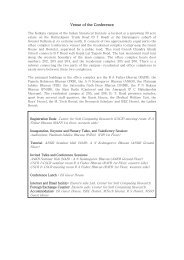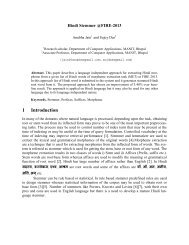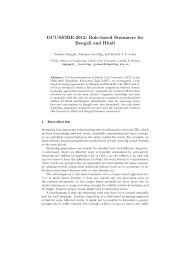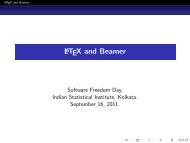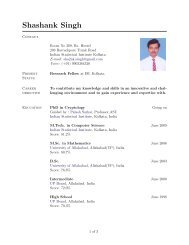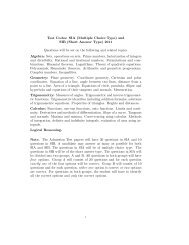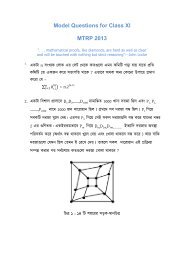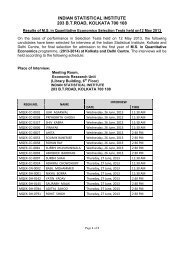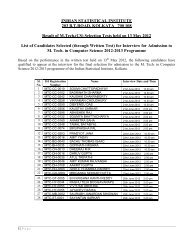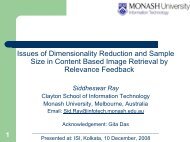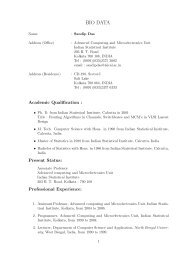2exploration along the front. However, a proper choice of thew i s remains challenging task.In addition to the earlier aggregating approaches of multi<strong>objective</strong>SA, there have been a few techniques that incorporatethe concept of Pareto-dominance. Some such methodsare proposed in [16], [17] which use Pareto-domination basedacceptance criterion in multi-<strong>objective</strong> SA. A good reviewof several multi-<strong>objective</strong> simulated annealing algorithms andtheir comparative performance analysis can be found in [18].Since the technique in [17] has been used in this article forthe purpose of comparison, it is described in detail later.In Pareto-domination-based multi-<strong>objective</strong> SAs developedso far, the acceptance criterion between the current and a newsolution has been formulated in terms of the difference in thenumber of solutions that they dominate [16], [17]. The amountby which this domination takes place is not taken into consideration.In this article, a new multi-<strong>objective</strong> SA is proposed,hereafter referred to as AMOSA (Archived <strong>Multi</strong>-<strong>objective</strong><strong>Simulated</strong> <strong>Annealing</strong>), which incorporates a novel concept ofamount of dominance in order to determine the acceptanceof a new solution. The PO solutions are stored in an archive.A complexity analysis of the proposed AMOSA is provided.The performance of the newly proposed AMOSA is comparedto two other well-known MOEA’s, namely NSGA-II [19] andPAES [20] for several function optimization problems whenbinary encoding is used. The comparison is made in termsof several performance measures, namely Convergence [19],Purity [21], [22], Spacing [23] and MinimalSpacing [21].Another measure called displacement [8], [24], that reflectsboth the proximity to and the coverage of the true PO front,is also used here for the purpose of comparison. This measureis especially useful for discontinuous fronts where we canestimate if the solution set is able to approximate all the subfronts.Many existing measures are unable to achieve this.It may be noted that the multi-<strong>objective</strong> SA methods developedin [16], [17] are on lines similar to ours. The concept ofarchive or a set of potentially PO solutions is also utilized in[16], [17] for storing the non-dominated solutions. Instead ofscalarizing the multiple <strong>objective</strong>s, a domination based energyfunction is defined. However there are notable differences.Firstly, while the number of solutions that dominate the newsolution x determines the acceptance probability of x in theearlier attempts, in the present article this is based on theamount of domination of x with respect to the solutions inthe archive and the current solution. In contrast to the worksin [16], [17] where a single form of acceptance probabilityis considered, the present article deals with different forms ofacceptance probabilities depending on the domination status,the choice of which are explained intuitively later on.In [17] an unconstrained archive is maintained. Note thattheoretically, the number of Pareto-optimal solutions can beinfinite. Since the ultimate purpose of an MOO algorithm isto provide the user with a set of solutions to choose from, it isnecessary to limit the size of this set for it to be usable by theuser. Though maintaining unconstrained archives as in [17] isnovel and interesting, it is still necessary to finally reduce itto a manageable set. Limiting the size of the population (asin NSGA-II) or the Archive (as in AMOSA) is an approachin this direction. Clustering appears to be a natural choice forreducing the loss of diversity, and this is incorporated in theproposed AMOSA. Clustering has also been used earlier in[25].For comparing the performance of real-coded AMOSAwith that of the multi-<strong>objective</strong> SA (MOSA) [17], six three<strong>objective</strong> test problems, namely, DTLZ1-DTLZ6 are used.Results demonstrate that the performance of AMOSA iscomparable to, often better than, that of MOSA in terms ofPurity, Convergence and Minimal Spacing. Comparison is alsomade with real-coded NSGA-II for the above mentioned sixproblems, as well as for some 4, 5, 10 and 15 <strong>objective</strong> testproblems. Results show that the performance of AMOSA issuperior to that of NSGA-II specially for the test problemswith many <strong>objective</strong> functions. This is an interesting and themost desirable feature of AMOSA since Pareto ranking-basedMOEAs, such as NSGA-II [19] do not work well on many<strong>objective</strong>optimization problems as pointed out in some recentstudies [26], [27].II. MULTI-OBJECTIVE ALGORITHMSThe multi-<strong>objective</strong> optimization can be formally statedas follows [1]. Find the vectors x ∗ = [x ∗ 1, x ∗ 2, . . . , x ∗ n] T ofdecision variables that simultaneously optimize the M <strong>objective</strong>values {f 1 (x), f 2 (x), . . . , f M (x)}, while satisfying theconstraints, if any.An important concept of multi-<strong>objective</strong> optimization is thatof domination. In the context of a maximization problem, a solutionx i is said to dominate x j if ∀k ∈ 1, 2, . . . , M, f k (x i ) ≥f k (x j ) and ∃k ∈ 1, 2, . . . , M, such that f k (x i ) > f k (x j ).Among a set of solutions P , the nondominated set of solutionsP ′are those that are not dominated by any member of theset P . The non-dominated set of the entire search space S isthe globally Pareto-optimal set. In general, a multi-<strong>objective</strong>optimization algorithm usually admits a set of solutions thatare not dominated by any solution encountered by it.A. Recent MOEA algorithmsDuring 1993-2003, a number of different evolutionary algorithmswere suggested to solve multi-<strong>objective</strong> optimizationproblems. Among these, two well-known ones namely, PAES[20] and NSGA-II [19], are used in this article for the purposeof comparison. These are described in brief.Knowles and Corne [20] suggested a simple MOEA usinga single parent, single child evolutionary algorithm, similar to(1+1) evolutionary strategy. Instead of using real parameters,binary strings and bit-wise mutation are used in this algorithmto create the offspring. After creating the child and evaluatingits <strong>objective</strong>s, it is compared with respect to the parent. If thechild dominates the parent, then the child is accepted as thenext parent and the iteration continues. On the other hand ifparent dominates the child, the child is discarded and a newmutated solution (a new solution) is generated from the parent.However if the parent and the child are nondominating to eachother, then the choice between the child and the parent isresolved by comparing them with an archive of best solutionsfound so far. The child is compared with all members of the
3archive to check if it dominates any member of the archive.If yes, the child is accepted as the new parent and all thedominated solutions are eliminated from the archive. If thechild does not dominate any member of the archive, both theparent and the child are checked for their nearness with thesolutions of the archive. If the child resides in a less crowdedregion in the parameter space, it is accepted as a parent and acopy is added to the archive. Generally this crowding conceptis implemented by dividing the whole solution space into d Msubspaces where d is the depth parameter and M is the numberof <strong>objective</strong> functions. The subspaces are updated dynamically.The other popular algorithm for multi-<strong>objective</strong> optimizationis NSGA-II proposed by Deb et al. [19]. Here, initiallya random parent population P 0 of size N is created. Thenthe population is sorted based on the non-domination relation.Each solution of the population is assigned a fitness whichis equal to its non-domination level. A child population Q 0is created from the parent population P 0 by using binarytournament selection, recombination, and mutation operators.Generally according to this algorithm, initially a combinedpopulation R t = P t + Q t is formed of size R t , which is 2N.Now all the solutions of R t are sorted based on their nondominationstatus. If the total number of solutions belongingto the best non-dominated set F 1 is smaller than N, F 1is completely included into P (t+1) . The remaining membersof the population P (t+1) are chosen from subsequent nondominatedfronts in the order of their ranking. To chooseexactly N solutions, the solutions of the last included frontare sorted using the crowded comparison operator and the bestamong them (i.e., those with larger values of the crowdingdistance) are selected to fill in the available slots in P (t+1) .The new population P (t+1) is now used for selection, crossoverand mutation to create a new population Q (t+1) of size N,and the process continues. The crowding distance operator isalso used in the parent selection phase in order to break a tiein the binary tournament selection. This operator is basicallyresponsible for maintaining diversity in the Pareto front.B. Recent MOSA algorithm [17]One of the recently developed MOSA algorithm is by Smithet al. [17]. Here a dominance based energy function is used. Ifthe true Pareto front is available then the energy of a particularsolution x is calculated as the total number of solutions thatdominates x. However as the true Pareto front is not availableall the time a proposal has been made to estimate the energybased on the current estimate of the Pareto front, F ′ , whichis the set of mutually non-dominating solutions found thusfar in the process. Then the energy of the current solution xis the total number of solutions in the estimated front whichdominates x. If ‖F ′ ′ ‖ is the energy of the new solution x′xand ‖F x‖ ′ is the energy of the current solution x, then energydifference between the current and the proposed solution iscalculated as δE(x ′ , x) = (‖F ′ ‖ − ‖F ′ x ′ x ‖)/‖F ′ ‖. Division by‖F ′ ‖ ensures that δE is always less than unity and providessome robustness against fluctuations in the number of solutionsin F ′ . If the size of F ′is less than some threshold, thenattainment surface sampling method is adopted to increase thenumber of solutions in the final Pareto front. Authors haveperturbed a decision variable with a random number generatedfrom the laplacian distribution. Two different sets of scalingfactors, traversal scaling which generates moves to a nondominatedproposal within a front, and location scaling whichlocates a front closer to the original front, are kept. Thesescaling factors are updated with the iterations.III. ARCHIVED MULTI-OBJECTIVE SIMULATEDANNEALING (AMOSA)As mentioned earlier, the AMOSA algorithm is based onthe principle of SA [3]. In this article at a given temperatureT , a new state, s, is selected with a probabilityp qs =1−(E(q,T )−E(s,T ))1 + e T, (1)where q is the current state and E(s, T ) and E(q, T ) are thecorresponding energy values of s and q, respectively. Note thatthe above equation automatically ensures that the probabilityvalue lies in between 0 and 1. AMOSA incorporates theconcept of an Archive where the non-dominated solutionsseen so far are stored. In [28] the use of unconstrainedArchive size to reduce the loss of diversity is discussed indetail. In our approach we have kept the archive size limitedsince finally only a limited number of well distributed Paretooptimalsolutions are needed. Two limits are kept on the sizeof the Archive: a hard or strict limit denoted by HL, anda soft limit denoted by SL. During the process, the nondominatedsolutions are stored in the Archive as and whenthey are generated until the size of the Archive increases toSL. Thereafter if more non-dominated solutions are generated,these are added to the Archive, the size of which is thereafterreduced to HL by applying clustering. The structure of theproposed simulated annealing based AMOSA is shown inFigure 1. The parameters that need to be set a priori arementioned below.• HL: The maximum size of the Archive on termination.This set is equal to the maximum number of nondominatedsolutions required by the user.• SL: The maximum size to which the Archive may be filledbefore clustering is used to reduce its size to HL.• Tmax: Maximum (initial) temperature.• Tmin: Minimal (final) temperature.• iter: Number of iterations at each temperature.• α: The cooling rate in SAThe different steps of the algorithm are now explained indetail.A. Archive InitializationThe algorithm begins with the initialization of a numberγ× SL (γ > 1) of solutions. Each of these solutions isrefined by using a simple hill-climbing technique, acceptinga new solution only if it dominates the previous one. Thisis continued for a number of iterations. Thereafter the nondominatedsolutions (ND) that are obtained are stored in theArchive, up to a maximum of HL. In case the number ofnondominated solutions exceeds HL, clustering is applied to



